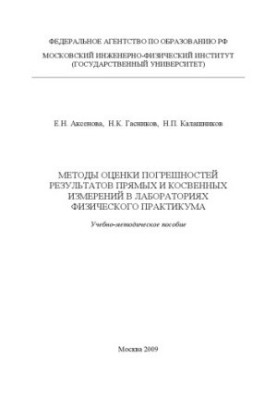Methods of assessing the errors of direct and indirect measurements in the laboratories of the physical workshop
 Instant download
Instant download
after payment (24/7)
 Wide range of formats
Wide range of formats
(for all gadgets)
 Full book
Full book
(including for Apple and Android)
The book "Methods for assessing errors in the results of direct and indirect measurements in the laboratories of the physical workshop", written by the author's team as part of Aksenov E . N. , Gasnikova N. K. Kalashnikova N . P. , is an important work that will become an indispensable assistant for students, graduate students and teachers involved in physics and related sciences. This work immerses the reader in the world of accuracy and reliability of measurements, which is a fundamental aspect of scientific research and the practical application of physical knowledge. The book covers a wide range of topics related to the assessment of errors, which makes it relevant for both beginners and experienced professionals. The authors consider in detail the methods that allow not only to identify, but also to quantify the errors that arise in the measurement process. They emphasize the importance of accuracy in scientific experiments, emphasizing that even the slightest deviation can lead to significant consequences in the interpretation of the results. Readers interested in physics, engineering, and related disciplines will find many useful tips and practical recommendations in this book. Students undergoing a physical workshop will be able to use the proposed methods to improve their skills in experimental research. Teachers, in turn, will be able to use the material of the book in the educational process, enriching their lectures and practical exercises. One of the key topics addressed in the book is the difference between direct and indirect measurements, as well as methods to assess the errors of each of these types. The authors explain how to interpret the measurement results correctly and what factors may influence their accuracy. This information will be especially useful for those who want to understand more deeply how to conduct experiments and analyze their results. The style of the authors is clear and accessible, which allows the reader to easily assimilate complex concepts. The book is written taking into account the modern requirements for scientific literature and contains many examples, illustrations and practical tasks, which makes it not only a theoretical, but also a practical manual. The authors, each of whom has significant experience in physics and teaching, successfully transfer their knowledge and skills, making the book especially valuable to the target audience. Among other well-known works of the authors are works devoted to the methodology of teaching physics and experimental methods in science. Each of these works also has a high level of scientific rigor and practical orientation, which makes them popular among students and teachers. The book "Methods for assessing errors in the results of direct and indirect measurements in the laboratories of the physical workshop" will become an indispensable resource for all who strive for accuracy and a deep understanding of physics. It will help readers not only improve their skills in conducting experiments, but also develop the critical thinking needed to analyze and interpret scientific data. If you are looking for a quality guide to measuring errors, this publication should definitely take its rightful place in your library.
LF/321479717/R
Data sheet
- Name of the Author
- Аксенова Е.Н.
Гасников Н.К.
Калашников Н.П. - Language
- Russian
- ISBN
- 9785726211404
- Release date
- 2009


























